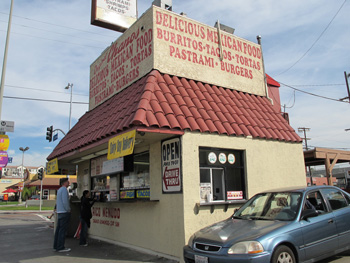 Customers order at Chano’s original “shack.” Customers order at Chano’s original “shack.” |
There’s a little drive-thru restaurant on South Figueroa Street, just north of the University of Southern California called Chano’s. It has been at the same location for the past 27 years. But surviving the most recent recession has been a challenge for its owner, who has fought hard to fulfill his dream of building a successful business and leaving a legacy for his family.
Don Macías spent years working at other people’s restaurants before deciding to start his own. “I learned to like the business,” says the 54-year old Macías, whose parents brought him to the United States from Mexico when he was two years old. “But after a few years, I didn’t like the boss anymore.” That’s when he turned to his parents for help. They lent him the money to get started.
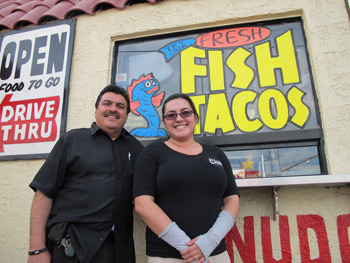 Don and Christina Macías, in front of the original Chano’s “shack.” Don and Christina Macías, in front of the original Chano’s “shack.” |
“There was nothing here. It was a car lot,” remembers Macías. He built Chano’s Drive-In restaurant from scratch in 1984. “I only built a small shack because I couldn’t afford to do anything bigger. I expanded slowly, putting tables outdoors for people to sit down and eat. Even though it’s small, it works the way it is.” The “shack” is still the same size, but he has improved the outdoor seating area since he first opened his little restaurant.
Macías picked the location on 3000 South Figueroa Street in South LA for one reason: He dreamt of sending his kids to USC and wanted to work nearby. Unfortunately, none of his eight children attended his dream school. He couldn’t afford it. But he has no regrets. Several of his children have already graduated from Cal State schools and others are currently attending college.
Despite some hard economic times, Chano’s is still in business. The original “shack” gets about 200 customers a day, but keeping the business open has been a struggle.
“It’s always been tough, but since 2008, it’s been tougher. Everything has gone up. We had to raise the price of our products and cut the hours of our employees,” he laments.
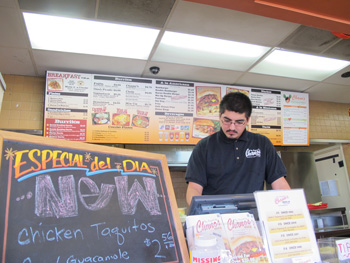 John Macías, at Chano’s second location on 3850 S. Figueroa St. John Macías, at Chano’s second location on 3850 S. Figueroa St. |
Macías recognizes there have been some good years in the past, allowing for expansion. At one point, he opened restaurants in Baldwin Park and Azusa, but sold them in the 1990’s for a profit. He also bought another South LA location in 2010 just eight blocks south on Figueroa Street, but sales there have been extremely sluggish. They barely get about 50 to 60 customers a day.
“It was a big risk, but the location became available and we wanted to expand the business. Besides, it’s close, so we don’t have to drive too far,” he explains. “It’s always a good investment, but like everything else, you have to wait… it’ll pay off in the long run.”
Throughout the years, Macías had relied more on his employees to do the work. But the recent recession has forced him to be a full-time employee at his restaurant once again. He also recruited three of his children – Christina, Don Jr. and John to help run the restaurants.
“I came to help him because he asked me for help and he never asked for help before,” recalls Christina. “It has now been about five years since I joined the family business.”
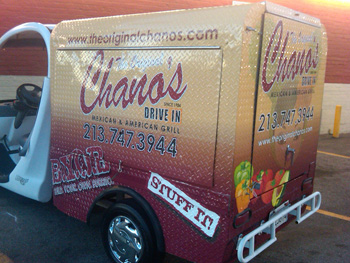 Chano’s invested in an electric car to make deliveries. Chano’s invested in an electric car to make deliveries. |
Father and daughter estimate they had a drop of about 10 to 20 percent in business since 2008. “But we’ve been able to come back a little bit,” says Christina. “We work a little longer, more family is participating and we work seven days a week. We try to leave our doors open as long as we can, so we can get more people in.”
Macías largely blames his slowdown on new competition: “In the last five years there’s at least 40 new restaurants on this street [Figueroa] all the way from Adams to Martin Luther King.”
“We’re competing with McDonald’s selling eight nuggets for a buck,” groans Christina. “It’s hard to compete with that when all our costs have gone up tremendously.”
For example, she says that in 2011 the cost of 50 pounds of beans was $18. Now, they have to pay more than double. Cooking oil shot up to $42 for 50 lbs from $20 a year ago. And a pound of carne asada went up from $1.89 last year to over $3.
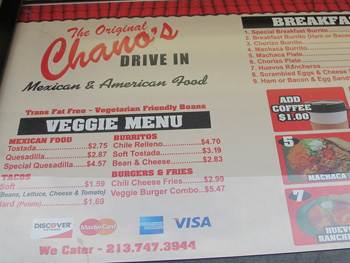 Chano’s now offers a popular vegetarian menu. Chano’s now offers a popular vegetarian menu. |
“We’ve always tried to keep prices reasonable, but we’ve had to increase them. We’ve done it in very small increments. Now we’re in the process of doing it again,” explains Christina.
Even with the price hikes, you can still get a taco under $2, a burger for under $3 and a burrito for $5. Heartier dishes on the menu cost more. The most expensive item is $7.50.
The Macías family is working hard to fend off the competition. They’re doing more portion control, added a popular vegetarian section to their menu and now offer catering. They also do deliveries in a small environmentally friendly electric car.
On the operations side, they’ve extended the restaurant’s hours of operations, staggered employees so they don’t all come in at the same time, reformatted the menu to include pictures of the food, launched a website and started a Facebook page to entice customers. In spite all their efforts, it hasn’t been easy to keep the doors open. Macías has tried getting a loan to help them with the overhead costs and ease their cash flow, but he complains the banks just aren’t lending.
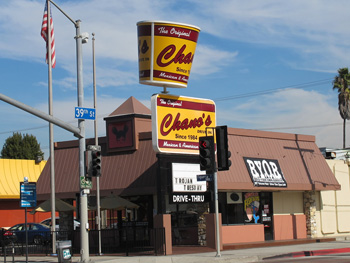 Chano’s second location at 3850 S. Figueroa St. Chano’s second location at 3850 S. Figueroa St. |
“Right now we’re working our buns off. We’re doing a lot of work ourselves,” says his daughter Christina. “We’ve talked about ways of saving money, including buying frozen goods because it would lower our costs and increase our profits, but it would lower the quality and that’s not the business model my father wants.”
Macías doesn’t want to compromise his standards. “The food is good and fresh, made daily; made to order. Our meat and vegetables come in every day…we even grate our own cheese,” he beams.
“It’s not just about making a paycheck,” says Christina. “We provide jobs. We help feed families… We only work with other small business, buy groceries locally and do our best to buy American. We’re only going to get out of this economy by giving back to our own communities. It’s a little extra work and it costs more, but we’re helping other people stay in business.”
After 27 years, Macías believes in keeping a positive outlook. “We learned we have to save. We have to watch everything we do more closely; we went back to the basics. But I think it’s getting better. People are spending money. I think this will be a good year.”















Speak Your Mind